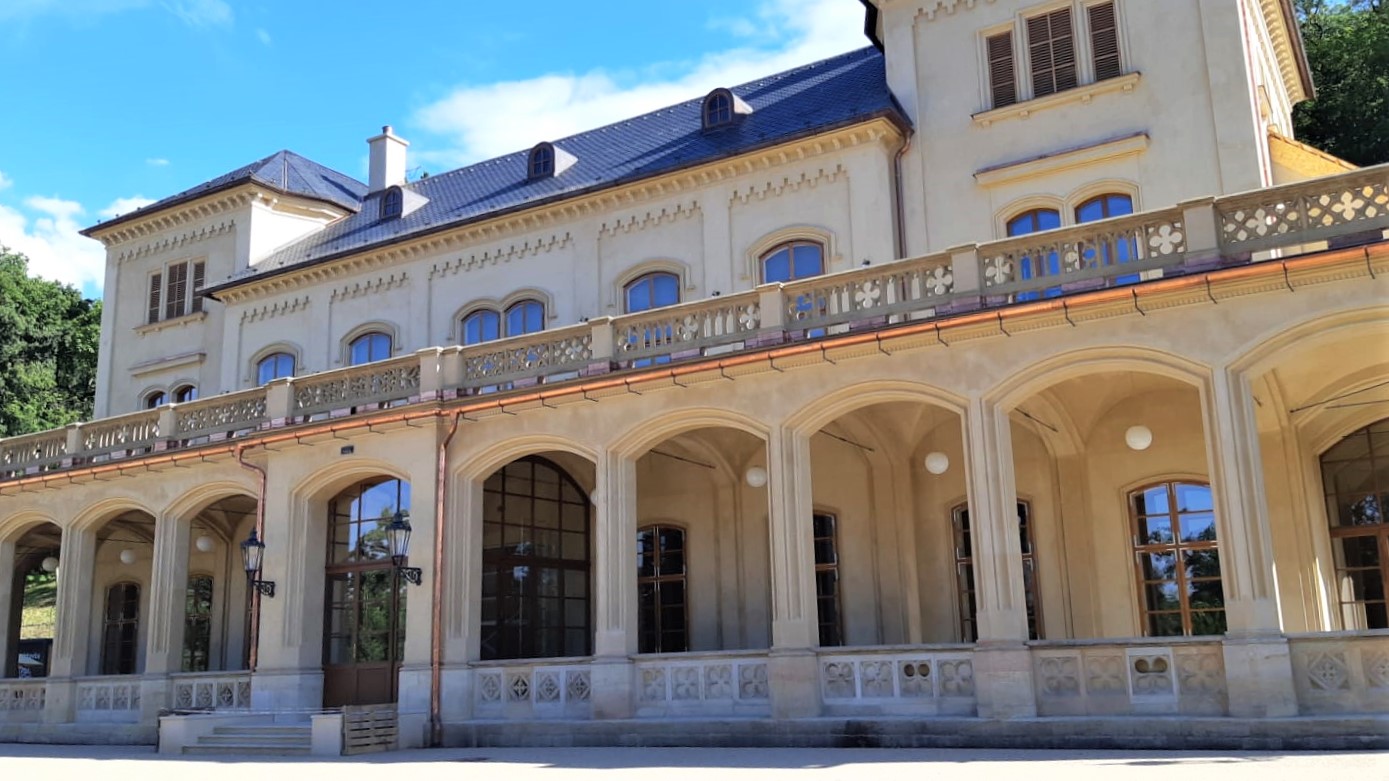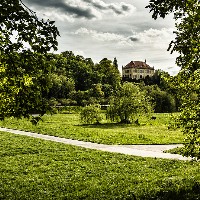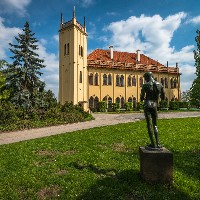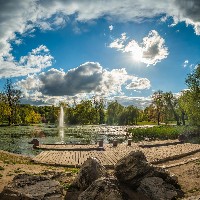Breadcrumbs navigation
Stromovka park - Prague's "Central Park"
An oasis of peace and relaxation, an island of greenery in the midst of a noisy metropolis: All this and more awaits you in the Royal deer-park, better known as the Stromovka, Prague’s largest park. This roughly 100 hectare (250 acre) site is open every day to a whole gamut of visitors. Here you will find Bohemian hipsters, lovey-dovey couples, joggers, in-line skaters and cyclists, families with kids of all ages, and dogs with their owners. From time to time you’ll come across a wedding ceremony held under the romantic canopy of ancient trees. Stromovka park has its unmistakable charm and takes life at its own pace.
The park dates back to 1268, founded by king Přemysl Otakar II to please himself and his Royal Court with a hunting-ground, and above it, a small Summer Palace. 750 years … that’ quite a bit of history. But let’s begin at the beginning. The Royal hunting-ground’s heyday was during the Hapsburg dynasty in the 16th and early 17th century. Emperor Ferdinand I expanded it in 1536-1548 and joined it through to Prague Castle. A pond was excavated, new trees planted, and a pheasant farm and hunting lodge built, later followed-up with a fruit garden. At the western edge, an Imperial mill sprang up, with a late-Renaissance gate, there to this day. Under Emperor Rudolph II the old Summer Palace got a Renaissance facelift and the original pond was generously enlarged to 21 hectares (52 acres). An island was raised in the middle, its remnant today dubbed Oak hillock – a central rise with ancient oak trees. The large pond was fed from Rudolph’s water tunnel – a technical feature remarkable in its day, still in service. It brought water from the Vltava River a hundred meters away (from near today’s Štefánik Bridge) through Letná hill; the entrance has a fine Renaissance portal inscribed with 1583 and the monogram of Rudolf II. A less happy era for the Royal hunting-ground came in the 17th and 18th century, when numerous military conflicts left their destructive mark – it was picked as an ideal military encampment site, more than once.
The modern history of this now public park in the English style with landscaped horticultural sections dates from 1804. Rudolf’s pond was partially filled-in, creating several smaller bodies of water and a sizeable clutch of meadows. The picturesque natural composition was rounded off with the planting of many ornamental and exotic tree species. During this time the Summer House, then in ruins, (since 1849 dubbed the “Governor’s”) was rebuilt in neo-Gothic style; and its surroundings made duly romantic. The Royal hunting-ground areas were joined up by pavements and paths, and the first gazebos, benches, and pond piers added. In the mid 19th century it got its current Prague vernacular name, the “Stromovka” – a loose translation of the German “Baumgarten”. Its final layout was set at the end of the 19th century by the building of the canal and railway line in the upper part of the Park, the tram loop on the East side, and definitively, by the construction of the Exhibition Grounds.
The most notable Stromovka building is Šlechtova restaurant, originally the Royal Hall from 1689-1691. The large hall was adorned with frescoes by Jan Jakub Steinfels depicting Apollo, Venus and Cupid, and other legendary scenes. A hundred years later, the building was rebuilt as a garden restaurant by František Antonín Herget, and again in 1855 in the neo-Gothic style by Bernard Grueber. In 1882 the restaurant was rented out by Václav Šlechta (hence the name), who ran it until the outbreak of World War II. His business prospered and it became an unmissable refreshments spot for anyone taking a Sunday stroll. In the postwar period, the “Šlechtovka” became dilapidated, through socialist economic stewardship, and several fires. The ravages of time were topped-off by the floods in 2002. Literally at the eleventh hour this architecturally valuable building got its reprieve, and should once again be open to the public after the refurbishment completes, during the year 2021.

Present-day Stromovka is writ large in the civic life of Prague and there is no sign of anything changing in that regard. On the contrary – the Park has latterly seen costly modernization, to match 21st century trends. Most notably, the central part has seen quite a transformation, bringing four kilometres of renovated paths, new ponds, footbridges and piers, several playgrounds, picnic sites and outdoor fitness installations. Additional updates, in the form of new lighting, benches and waste bins, were due recently. Certainly worth a mention are the unconventional children’s playground elements, restored by Prague City Hall. These include the original reinforced concrete sculptures made more than 50 years ago by sculptor Olbram Zoubek and his wife Eva Kmentová. The overall effect is that of an outdoor gallery, bringing the public space to life. Not surprisingly, the positive changes in the Park’s infrastructure are reflected in its visitor numbers – Stromovka Park gets 4 million visitors a year.
In search of culture and history:
Lapidary![]() Výstaviště Praha 422
Výstaviště Praha 422 ![]() nm.cz
nm.cz
A unique historical collection of roughly four hundred of the best stonework and sculptural originals from the 11-19th centuries.
Marold Panorama![]() Výstaviště Praha 417
Výstaviště Praha 417 ![]() vystavistepraha.eu
vystavistepraha.eu
A panoramic painting of the Battle of Lipany (1434) with real objects in the foreground, creating an illusory three-dimensional space. This remarkable work by the painter Luděk Marold from the late 19th century is the largest depiction of a historical event in the Czech Republic.
Trade Fair Palace![]() Dukelských hrdinů 47
Dukelských hrdinů 47 ![]() ngprague.cz
ngprague.cz
This building, belonging to the Prague National Gallery, houses a collection of international and local modern and contemporary art.
Planetarium![]() Královská obora 233
Královská obora 233 ![]() planetum.cz
planetum.cz
The Prague Planetarium, with a projection dome 23.5 m across is one of the largest of its kind in the world. State-of-the-art audiovisual equipment turns the projection dome into a perfectly cosmic illusion.
Old Wastewater Treatment Plant![]() Papírenská 6
Papírenská 6 ![]() staracistirna.cz
staracistirna.cz
This national cultural and industrial heritage building is exceptionally well preserved, with its distinctive underground complex and original technology.
Prague Zoo![]() U Trojského zámku 120/3
U Trojského zámku 120/3 ![]() zoopraha.cz
zoopraha.cz
Its matchless location and great biodiversity make Prague Zoo one of the most beautiful zoos in the world. Its varried terrain offers an exotic walk of up to ten kilometres, including an African savannah, an Indonesian jungle, or the Valley of the Elephants. In 2017 it placed 5th in the world in the TripAdvisor rankings.

Pastimes galore:
The wharf at Císařský ostrov/island![]() navigable canal
navigable canal
There are regular two-way cruises between downtown Prague (Rašínovo embankment or Čechův bridge) and this "Imperial" island.
Horse and pony riding school![]() Císařský ostrov 1098
Císařský ostrov 1098 ![]() ponici.cz
ponici.cz
This riding school provides comprehensive horse-riding tuition for children and adults, with rides around Stromovka Park, where there are secluded bridleways.
Matějská pouť | St Matthew’s Fair![]() Výstaviště Praha
Výstaviště Praha ![]() matejskapout.cz
matejskapout.cz
The most widely known and loved annual Funfair in the Czech Republic, held each Spring at the Prague Exhibition Grounds.
Coffee, Lunch, or Dinner:
Vozovna Stromovka![]() Královská obora 2
Královská obora 2 ![]() vozovna-stromovka.cz
vozovna-stromovka.cz
This garden restaurant benefits from the modernized facilities of the original tram yard that used to stand here until the 1930s. You can also enjoy the spacious garden, or the terrace with its pleasant views of the greenery.
Na Slamníku | ‘On the haybed’![]() Wolkerova 12
Wolkerova 12 ![]() na-slamniku.cz
na-slamniku.cz
This legendary restaurant in Bubeneč dates back to the 17th century, offering traditional Czech food. The dining hall regularly hosts concerts by lesser-known or upcoming Czech bands.
Pražan | ‘Praguer’![]() Výstaviště 67
Výstaviště 67 ![]() pivovarprazan.cz
pivovarprazan.cz
The building dates back to the "Jubilee Territorial Exhibition" of 1891. After the exhibition was over, the pavilion found its place, as the Pražan (‘Praguer’) restaurant. Following its recent refurbishment, it is once again open to the public.
V zahradě | ‘In the garden’![]() Schwaigerova 59/3
Schwaigerova 59/3 ![]() vzahrade.com
vzahrade.com
This restaurant of the Schwaiger Hotel specializes in upmarket gastronomy and modern Czech cuisine. All dishes are prepared from carefully selected ingredients sourced exclusively from local markets and farms. Its added bonus is its own smoker facility, for meat, fish and vegetables.
Café Továrna![]() Papírenská 6
Papírenská 6 ![]() staracistirna.cz
staracistirna.cz
A cosy café with a stylish ambience, right on the premises of the historical Old Wastewater Treatment Plant. You can also buy packs of coffee and tea and all the sundries to brew your own.
How to get there:
Train – Prague – Holešovice station
Metro – C, Nádraží Holešovice
Tram – 6, 12, 14, 17, (night service 93, 94)
Author: Jan Pomykal - Web Content and Publishing Department


